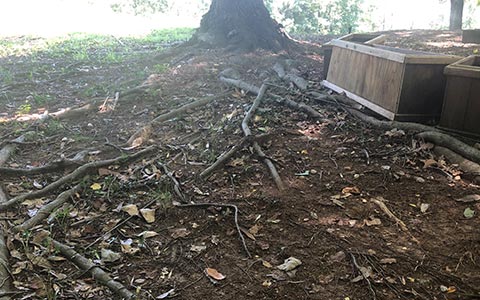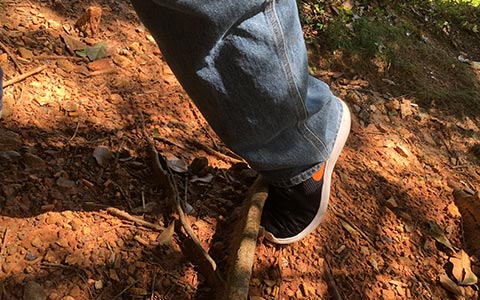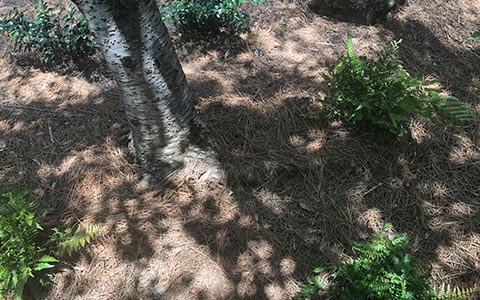Notice: Undefined variable: page in /home/vrxdg1855sn3/public_html/wp-content/themes/72tree/content.php on line 15
Notice: Trying to get property 'ID' of non-object in /home/vrxdg1855sn3/public_html/wp-content/themes/72tree/content.php on line 15
How to Fix Exposed Tree Roots

Are ugly surface roots buckling your concrete driveway or stopping you from mowing your lawn? Before you get frustrated and cut them out, there are some things you need to know.
72tree.com gathered the following information on how to handle surface roots without compromising the health of your tree.
Why Do Tree Roots Surface
While some roots grow deep in the ground, the majority of them spread out from the trunk within the first 4 to 12 inches of soil. As the tree ages, several factors may bring them to the surface:
Erosion – Over time, the top layers of soil may be washed away, lowering the ground level, subsequently exposing tree roots.
Soil Compaction – As tree roots spread out, they seek moist aerated soil to derive water and nutrients. When they run into compacted soil, they will turn downward or upward, and in many cases will grow along or just beneath ground level.
Natural Growth – The same way a tree trunk and limbs increase their girth with age, so do roots. Since the majority of tree roots grow within the first few inches of soil, they tend to break the surface as they thicken.
Species – Some trees grow this way. Species such as maples, poplars, and willows tend to grow surface roots.
As annoying as it may be, surface roots are a common landscape problem that can cause significant and costly damage.
Surface Root Problems
When tree roots surface, there are many potential issues they bring with them. Those issues may include:
Disease, Infestation, and Rot – Surface roots are highly susceptible to being injured or damaged by landscaping equipment, foot traffic, or wildlife. Damaged surface roots are easily infected by disease, or infested by insects and can carry harmful pathogens to the trunk and branches of the tree.
Damaged Driveway or Sidewalk – As these roots thicken and surface, the ones that have grown under sidewalks, driveways, and foundations will eventually exert enough pressure to raise or break them.
Read more on how tree roots can buckle a driveway and what to do at 72tree.com/tree-roots-buckling-concrete-driveway/
Damaged Landscape Equipment – Lawnmowers and other mechanical equipment can be severely damaged when making contact with surfaced tree roots.
Abnormal Growth – Where Tree roots surface, any grass or plant life surrounding those roots may become sparse or die.
Trip Hazard – When surface roots are further exposed by erosion, they may become a severe trip hazard when navigating your landscape.

Surface Root Solutions
While cutting the roots away may seem to be the best alternative, it is not. Cutting away roots (like damaging them) leaves the tree highly susceptible to deadly diseases and infestation.
The following are ways to resolve surface root issues without causing severe damage to the tree:
Mulch – At the first sign of roots breaking the surface, lay down a 2 to 3-inch layer of organic mulch. Mulch will help the soil retain moisture, and over time may redirect the roots to grow downward.
Soil Replacement – In cases of erosion exposing roots, lay down a 3 to 4-inch layer of soil to replace what was eroded. To prevent further erosion, you can mulch the area around the tree, seed the new soil with grass, or lay down sod.
Plant Plants – Where erosion is not the problem, one solution may be planting the area with taller ground cover or plants that won’t need mowing. As you create this “tree root garden,” take care to avoid damaging the roots while planting.

If you are still inclined to have the roots removed, hire an arborist to do this for you. Depending on the damage that may have already occurred, and type of roots that will be removed, it may be suggested to remove the tree.
Surface Root Prevention
Avoid the inconvenience of surface roots by taking action before they come to the surface:
Planting Location – Each tree species has a preferred type of soil, light, and nutrients for healthy growth. By planting trees in optimal conditions for their species, roots will be less likely to surface as the tree ages.
Soil – The soil type, moisture level, nutrient content, and pH level affect how tree roots grow. Deep watering, seasonal fertilizing, and annual pH level adjustments will encourage tree roots to grow deeper.
Species – As mentioned earlier, some tree species are prone to grow surface roots. When selecting trees for your landscape or yard, be sure to ask about the tree’s growth patterns, and do your research on the species needs for optimal growing conditions.
Read more about tree planting and care at 72tree.com/tree-planting-guide/
Exposed Tree Root Solutions
Don’t let gnarly surface roots discourage you from having a beautiful landscape. There are ways to incorporate them in your design without fatally wounding your tree.
In this article, you discovered why tree roots come to the surface, the problems they can cause, and measures you can take to solve and prevent them.
Your mishandling or damaging of surface roots can lead to the health decline and death of your tree. Before you cut roots away, call a professional to evaluate the situation and offer alternatives to save your landscape and your tree.
Sources:
https://extension.umd.edu/hgic/topics/surface-roots
https://www.purdue.edu/hla/sites/yardandgarden/when-tree-roots-surface/
